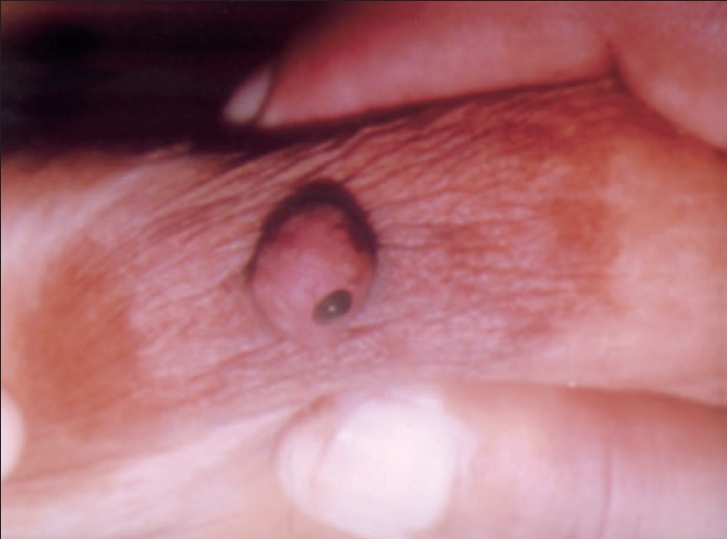Translate this page into:
Apocrine chromhidrosis localized to the areola in an Indian female treated with topical capsaicin
Correspondence Address:
Vijay Gandhi
A- 242, Surya Nagar, Ghaziabad - 201 011
India
| How to cite this article: Gandhi V, Vij A, Bhattacharya S N. Apocrine chromhidrosis localized to the areola in an Indian female treated with topical capsaicin. Indian J Dermatol Venereol Leprol 2006;72:382-383 |
 |
| Black secretion from the areola in droplets |
 |
| Black secretion from the areola in droplets |
Sir,
Apocrine chromhidrosis is characterized by secretion of colored apocrine sweat. The color results from lipofuscin pigment in apocrine secretions. The colors vary from blue, black, yellow to green.[1],[2]
A 28-year-old North Indian female presented with complaints of black staining of undergarments over the breasts for the last five to six years. Staining was more prominent during summer. There was no history of relevant drug intake during this period including oral contraceptives. Examination revealed a dark black secretion over the areola of breasts, which could be expressed out in multiple droplets on squeezing the surrounding area [Figure - 1]. The surrounding skin was normal in appearance. No evidence of colored sweat was found on the face and axillary areas. A skin swab from the involved area was negative for bacterial growth. Urine examination for pregnancy was negative and serum prolactin levels were normal. On the basis of history and clinical examination, a diagnosis of apocrine chromhidrosis was made.
She was started on topical capsaicin (0.1%) gel locally once daily. The secretion decreased in amount after two weeks of application. At eight weeks of treatment, she reported 60% decrease in the secretion. Patient initially complained of an intense burning sensation after each application of capsaicin lasting for two to three hours. A mild erythema had also developed on the application site at one week. However the burning sensation reduced gradually in intensity and became tolerable. At eight weeks she continued to have burning sensation lasting for half an hour after each application. Erythema had also decreased. She is presently continuing the use of topical capsaicin.
Apocrine chromhidrosis is a localized disease predominantly affecting the skin bearing apocrine glands. Two varieties are described-axillary and facial. The pigment lipofuscin is produced inside the apocrine gland in contrast to pseudochromhidrosis in which surface bacteria, fungi and dyes cause color formation.[1] Involvement of the areola has been reported.[3] Colored sweating can be induced by physical activity and emotional factors and patients are usually able to express out the sweat droplets mechanically. Histopathology shows increased number of lipofuscin granules in the secretory cells of apocrine glands. The disease runs a chronic course improving slowly with age.
Capsaicin acts by causing stimulation of afferent unmyelinated nerve fibers causing release of substance P stored in synaptic vesicles. Substance P is found primarily in afferent sensory fibers, dorsal root ganglia and the dorsal horn of the spinal cord. Prolonged use leads to depletion of substance P in the unmyelinated, slow-conducting type C sensory fibers.[2],[4],[5] However, the exact mechanism of action in apocrine chromhidrosis is not known. Probably it inhibits the acetylcholine mediated release of sweat at the sympathetic nerve endings.
| 1. |
Daoud MS, Dicken CH. Disorders of Apocrine sweat glands. In : Freedberg IM, Eisen AZ, Wolff K, Austen KF, Goldsmith LA, Katz SI, editors. Fitzpatrick's Dermatology in general medicine. 6th ed. Mc Graw-Hill: New York; 2003. p. 708-9.
[Google Scholar]
|
| 2. |
Coulson IH. Disorders of sweat glands. In : Burns T, Breathnach S, Cox N, Griffiths C. editors. Rook/ Wilkinson/ Ebling Textbook of dermatology. 7h ed. Blackwell Science: Oxford; 1998. p. 45.22-45.33.
[Google Scholar]
|
| 3. |
Saff DM, Owens R, Kahn TA. Apocrine chromhidrosis involving the areola in a 15 yr. old amateur figure skater. Pediat Dermatol 1995;12:48-50.
[Google Scholar]
|
| 4. |
Marks JG Jr. Treatment of apocrine chromhidrosis with topical capsaicin. J Am Acad Dermatol 1989;21:418-20.
[Google Scholar]
|
| 5. |
Griffith JR. Isolated areolar apocrine chromhidrosis. Pediatrics 2005;115:e239-41.
[Google Scholar]
|
Fulltext Views
2,893
PDF downloads
805





